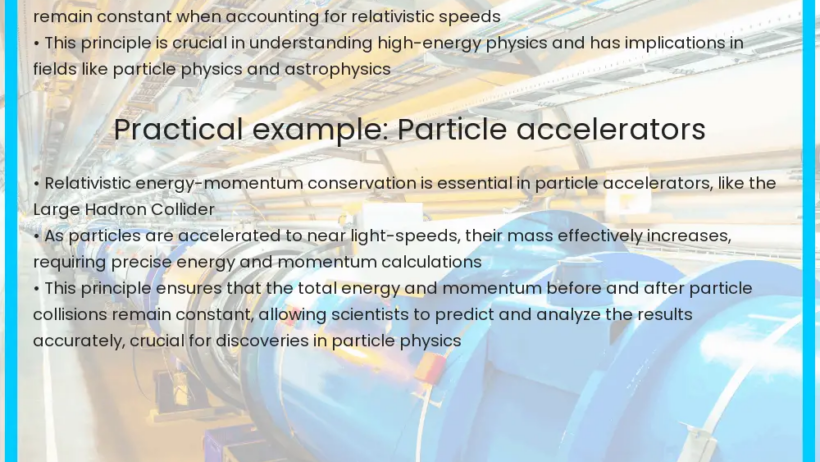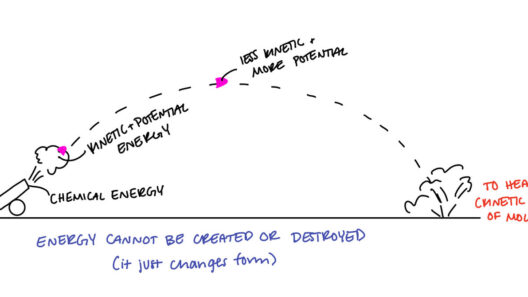The principles of conservation of energy and momentum are cornerstone concepts in physics, underlying a multitude of phenomena within the universe. Understanding these principles can fundamentally alter the way we perceive interactions in both macroscopic and microscopic realms. This exploration not only emphasizes the interrelation of various physical processes, but also showcases the intrinsic elegance of the natural world.
At its core, the law of conservation of energy stipulates that energy cannot be created nor destroyed, but only transformed from one form to another. This immutable principle is a beacon illuminating the multidimensional complexity of energy in various formats: kinetic, potential, thermal, and chemical, among others. Each form plays critical roles in the tapestry of interactions that compose our reality.
Consider a swinging pendulum: as it moves, gravitational potential energy transforms into kinetic energy at the lowest point of its swing. When ascending, kinetic energy reverts back into potential energy. This continual exchange exemplifies the essence of energy conservation. However, real-world systems often experience losses due to factors like friction and air resistance, leading to what is known as dissipative forces. These forces tend to obscure the conservation narrative, yet they do not undermine the principle on a grand scale.
Now, let us delve deeper into the concept of momentum. Momentum, defined as the product of an object’s mass and its velocity, embodies the quantity of motion an object possesses. The conservation of momentum states that within a closed system—one not influenced by external forces—total momentum remains constant. This intriguing principle serves as an analytical tool in various scenarios ranging from explosive collisions to celestial mechanics.
The elegance of momentum conservation becomes evident in elastic and inelastic collisions. In elastic collisions, kinetic energy and momentum are conserved, making them ideal scenarios for exploring these principles. During such interactions, particles rebound without losing kinetic energy, allowing for the calculation of post-collision velocities based upon initial conditions. In contrast, inelastic collisions do not conserve kinetic energy; instead, some energy dissipates as internal energy, often converting into heat or sound. While the total momentum remains conserved in both scenarios, the shift in energy reveals the nuanced complexities involved in conservation laws.
One critical realization that arises from examining the conservation of energy and momentum is their physical implications on processes at the atomic and subatomic levels. This perspective extends to the realms of quantum mechanics and relativity. In these domains, classical definitions blur, yet the adherence to conservation laws persists. Quantum field theory, for instance, incorporates energy and momentum conservation in its framework, depicting how particles interact through force carriers. Understanding these principles evokes a sense of unity across disparate scales of the universe.
The conservation of energy intertwines with the laws of thermodynamics, elucidating further layers of complexity. The first law of thermodynamics asserts the conservation of energy within systems, while the second law introduces the notion of entropy—a measure of energy dispersal and disorder. This interplay suggests an inevitable march toward greater entropy, underlining the importance of understanding our energy consumption amidst the backdrop of an ever-increasing demand for resources.
Furthermore, contemporary challenges in energy sustainability and environmental stewardship require a profound comprehension of energy conservation principles. As society becomes increasingly aware of the finite nature of fossil fuels and the urgent need to combat climate change, the insights drawn from energy conservation can inspire innovative approaches to harnessing renewable resources. Wind, solar, and hydropower epitomize the transition toward sustainable practices, grounded in the principles of energy transformation rather than depletion.
The discussion branches out into practical applications of conservation laws across engineering and technology. For instance, rocket propulsion elucidates the conservation of momentum. By expelling gas at high velocity, rockets adhere to Newton’s third law while effectively conserving momentum. This is evidenced by the principle of thrust, which underpins the design of successful space missions. Every launch epitomizes not just the triumph of engineering but the enduring legacy of conservation laws governing our physical world.
A fundamental paradigm shift occurs when recognizing the relationship between energy, momentum, and ecological conservation. A burgeoning understanding of these principles can empower individuals and communities to rethink their approach toward consumption and resource management. Examining the broader implications of personal choices—such as energy-efficient technology, transportation alternatives, and ecological footprint—can propel social movements towards responsible stewardship of our planet’s resources.
Moreover, education plays a pivotal role in disseminating knowledge of these principles. STEM (Science, Technology, Engineering, Mathematics) learning cultivates awareness of the laws of conservation, fostering an environmentally conscious generation equipped to tackle pressing ecological issues. Schools and institutions have the opportunity to integrate these concepts into curricula, inspiring future engineers, policymakers, and activists to prioritize sustainability.
The conservation laws of energy and momentum thus serve as guiding principles that resonate beyond physics classrooms and laboratory settings. Their implications reach far into our environmental consciousness, urging a collective shift in perspective. Embracing these principles does not merely enrich our scientific understanding; it can catalyze monumental changes across economies, societies, and industries as they pivot towards sustainable futures.
In conclusion, the intricate dance between energy and momentum not only delineates our physical world but also beckons a deeper inquiry into how we engage with it. The conservation of energy and momentum reveals an interconnectedness that transcends disciplines, whispering a universal truth: the essence of our existence is in the perpetual flow and transformation of energy. By embracing these principles, we can harness them to foster innovation, enhance sustainability, and protect our shared environment for generations to come.








